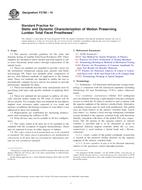Potřebujeme váš souhlas k využití jednotlivých dat, aby se vám mimo jiné mohly ukazovat informace týkající se vašich zájmů. Souhlas udělíte kliknutím na tlačítko „OK“.
ASTM F2790-10
Standard Practice for Static and Dynamic Characterization of Motion Preserving Lumbar Total Facet Prostheses
Automaticky přeložený název:
Standardní praxe pro statické a dynamické Charakteristika pohybu Zachování bederní Celkem Fazetová Protézy
NORMA vydána dne 1.1.2010
Informace o normě:
Označení normy: ASTM F2790-10
Poznámka: NEPLATNÁ
Datum vydání normy: 1.1.2010
Kód zboží: NS-54542
Počet stran: 9
Přibližná hmotnost: 27 g (0.06 liber)
Země: Americká technická norma
Kategorie: Technické normy ASTM
Anotace textu normy ASTM F2790-10 :
Keywords:
dynamic stabilization, dynamic test, facet arthroplasty, posterior instrumentation, spinal implants, static test, ICS Number Code 11.040.40 (Implants for surgery, prothetics and orthotics)
Doplňující informace
| Significance and Use | ||||||||||||
|
Facet Prosthesis Components—The facet replacement may comprise a variety of shapes and configurations. Its forms may include, but are not limited to, ball and socket articulating joints, joints having a free-floating or semi-constrained third body, metallic load-bearing surfaces, and spring and dampening mechanisms. Additionally, it may be a unilateral or bilateral design. These test methods are designed to quantify the static and dynamic characteristics of different designs of FP. The tests are conducted in vitro in order to allow for analysis of individual devices and comparison of the mechanical performance of multiple designs. The loads applied to the FP may differ from the complex loading seen in vivo, and therefore, the results from these tests may not directly predict in vivo performance. The results, however, can be used to compare mechanical performance in different devices. Fatigue testing in a simulated body fluid or saline may cause fretting, corrosion, or lubricate the interconnections and thereby affect the relative performance of tested devices. This test should be conducted in a 0.9 % saline environmental bath at 37°C at a maximum rate of 10 Hz for all metallic devices and 2 Hz for non-metallic devices. Other test environments such as a simulated body fluid, a saline drip or mist, distilled water, other type of lubrication or dry could also be used with adequate justification. Likewise, alternative test frequencies may be used with adequate justification to ensure that it does not impact the device performance. It is well known that the failure of materials is dependent upon stress, test frequency, surface treatments, and environmental factors. Therefore, when determining the effect of changing these parameters (for example, frequency, material, or environment), care should be taken to allow for appropriate interpretation of the results. In particular, it may be necessary to assess the influence of test frequency on device fracture while holding the test environment, implant materials and processing, and implant geometry constant. |
||||||||||||
| 1. Scope | ||||||||||||
|
1.1 This practice provides guidance for the static and dynamic testing of Lumbar Total Facet Prostheses (FP). These implants are intended to allow motion and lend support to one or more functional spinal unit(s) through replacement of the natural facets. 1.2 These test methods are intended to provide a basis for the mechanical comparison among past, present, and future non-biologic FP. These test methods allow comparison of devices with different methods of application to the lumbar spine. These test methods are intended to enable the user to mechanically compare devices and do not purport to provide performance standards for them. 1.3 These test methods describe static and dynamic tests by specifying load types and specific methods of applying these loads. 1.4 These test methods do not purport to address all clinically relevant failure modes for FP, some of which will be device specific. For example, these test methods do not address implant wear resistance under expected in vivo loads and motions. In addition, the biologic response to wear debris is not addressed in these test methods. 1.5 Requirements are established for measuring displacements and evaluating the stiffness of FP. 1.6 Some devices may not be testable in all test configurations. 1.7 The values stated in SI units are to be regarded as the standard with the exception of angular measurements, which may be reported in terms of either degrees or radians. 1.8 The values stated in inch-pound units are to be regarded as standard. The values given in parentheses are mathematical conversions to SI units that are provided for information only and are not considered standard. |
||||||||||||
| 2. Referenced Documents | ||||||||||||
|
Odebírejte informace o nově vydaných normách ZDARMA:
Chcete pravidelně odebírat informace o nově vycházejících normách z celého světa a to zcela zdarma?
Přihlašte se k odběru. Vše je velice jednoduché a absolutně ZDARMA.
Na výběr máte vydavatele z celého světa.




 Cookies
Cookies
